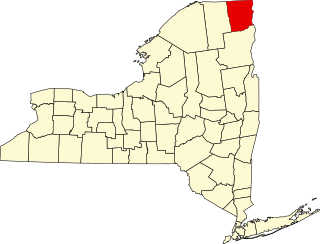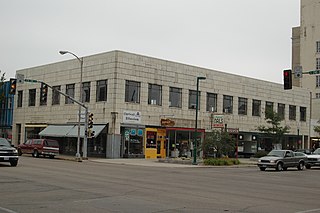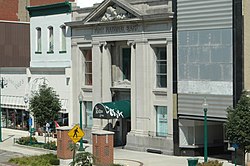
List of the National Register of Historic Places listings in Clinton County, New York

The Howes Building is a historic building located in Clinton, Iowa, United States. The four-story, brick, Neoclassical structure features arched windows, pilasters, and a chamfered corner. At one time it had a prominent entrance on the corner that was flanked by columns in the Doric order. The columns remain in place even though the entrance has been modified. The architect for the first three stories, finished in 1900, was Josiah Rice. The fourth story, finished five years later, was designed by John Morrell. Both were local architects, Morrell having purchased the Rice firm in 1903. The contractor was John Lake. Edward M. Howes had the building constructed during a period of population and economic growth in Clinton. The two upper floors have housed the offices of local professionals. The first and second floors have housed various retail establishments, including Kline's Department Store, Stage Department Store, Jefferson Billiards Shop, Metzger and Cavanaugh Men's Tailors, and the Kaybee Store. The building has been listed in the National Register of Historic Places since 2004.

The Clinton House is an 18th-century Georgian stone building in the city of Poughkeepsie, Dutchess County, New York, United States. It is a New York State Historic Site and has been listed in the National Register of Historic Places as a historic place of local significance since 1982. The house was named for George Clinton, who served as the first Governor of New York and fourth Vice-President of the United States. He was believed to have lived there after the American Revolutionary War, but it is now known that it was never his residence.
The New Jersey Register of Historic Places is the official list of historic resources of local, state, and national interest in the U.S. state of New Jersey. The program is administered by the New Jersey's state historic preservation office within the New Jersey Department of Environmental Protection.

This is a list of the National Register of Historic Places listings in Clinton County, Pennsylvania.

This is a list of the National Register of Historic Places listings in Clinton County, Ohio.

This is a list of the National Register of Historic Places listings in Clinton County, Iowa.

This is a list of the National Register of Historic Places listings in Tippecanoe County, Indiana.

This is intended to be a complete list of the properties and districts on the National Register of Historic Places in Clinton County, Indiana, United States. Latitude and longitude coordinates are provided for many National Register properties and districts; these locations may be seen together in a map.

St. John the Baptist Roman Catholic Church and Rectory is a historic Roman Catholic church and rectory located at 20 Broad Street in Plattsburgh, Clinton County, New York. Both structures were added to the National Register of Historic Places as one record in 1982.

Clinton Village Village Historic District is a national historic district located at Clinton in Oneida County, New York. The district includes 144 contributing buildings, two contributing structures, two contributing sites, and six contributing objects.

The Bridgeport Bridge was a historic structure located near Denmark, Iowa, United States. This span was a replacement bridge for the original structure whose middle stone pier was deteriorating. The weaknesses in the old bridge were noted in 1887 and 1893. Both Des Moines and Lee counties financed the $5,110 construction of this bridge, which spanned the Skunk River between the two counties. The 240-foot-long (73 m) Pennsylvania truss bridge was built in 1904 by the Clinton Bridge and Iron Works of Clinton, Iowa. It carried local traffic for nearly 90 years before it was closed.

The Clinton Downtown Historic District is a historic district located in the village of Clinton in Clinton Township in the northernmost portion of Lenawee County, Michigan. It consists of most of the 100 block of U.S. Route 12, known locally as West Michigan Avenue, plus Memorial Park at 200 West Michigan. The district was added to the National Register of Historic Places on April 27, 2010.

The Ankeny Building is a historic structure located in downtown Clinton, Iowa. Chicago architect Harold Holmes designed the building in the Art Deco style. It was built by Daniel Haring in 1931. The exterior is covered with cream-colored terra cotta panels. The windows on the second floor are examples of the Chicago school and they are composed of steel and glass. It was listed on the National Register of Historic Places in 2006.

Cherry Bank, also known as the Dr. A. L. Ankeny House and Lindmeier ("Cherrybank"), is an historic residence located in Clinton, Iowa, United States. The Italianate style house was built in 1871 by Dennis Warren. He meant the house for his favorite nephew, but Dr. Ankeny bought and lived in the house instead. The two-story structure is composed of red brick and has buff-colored brick for the quoins and the window arches. It features a cornice, hipped roof, and a widow's walk. The original front porch was removed in the 1920s. It was listed on the National Register of Historic Places in 1999.

The Clinton–Hardy House on S. Guthrie in Tulsa, Oklahoma was built in 1919. It was designed by architect George Winkler and built for Mr. and Mrs. Lee Clinton. It was listed on the National Register of Historic Places in 1979.

Hawkeye Creek Bridge is a historic structure located in a rural area northeast of Mediapolis, Iowa, United States. The Des Moines County Board of Supervisors contracted with Clinton Bridge and Iron Works on September 23, 1909, to design and build this bridge. It is an 80-foot (24 m) span that carries traffic of a gravel road over Hawkeye Creek. The structure is a single rigid-connected Pratt through truss that is supported by concrete abutments. It basically remains in an unaltered condition. The bridge was listed on the National Register of Historic Places in 1998.

The Upper Iowa River Bridge, also known as the Hartley Bridge, is a historic structure located southeast of Dorchester, Iowa, United States. It spans the Upper Iowa River for 122 feet (37 m). Allamakee County built the first permanent bridge at this location around 1870. By the early 1910s it had deteriorated to the point of needing to be replaced, and it was removed in 1913. At the time this was on the main road between Dorchester and New Albin. Chambers and Dobson of New Hampton, Iowa was awarded the $2,585 to build the concrete superstructure. The Clinton Bridge and Iron Works of Clinton, Iowa fabricated and erected the Pratt truss structure for $3,490. It was completed in July 1914, and was one of the last bridges erected in the state before the Iowa State Highway Commission standardize bridge designs for through truss bridges. It was listed on the National Register of Historic Places in 1998.
The Little Sioux River Bridge is a historic structure located northwest of Spencer, Iowa, United States. It spans the Little Sioux River for 180 feet (55 m). The bridge was originally located at Main Street, south of downtown Spencer over the same river. Two previous bridges had been located at the original location beginning in 1875, with a replacement in 1889. Clay County contracted with Clinton Bridge and Iron Works from Clinton, Iowa in 1900 to build this Pennsylvania through truss span. Completed the following year, it is the rare example of this type of bridge built in Iowa. A concrete arch span replaced this bridge in 1915, and it was moved to its current location the same year. The concrete abutments were built by Thor Construction Company from Cedar Falls, Iowa. The bridge was listed on the National Register of Historic Places in 1998.

First Unitarian Church is a historic building located in the downtown area of Iowa City, Iowa, United States. The local Universalist congregation traces its beginnings to 1841. Their building at Iowa Avenue and Dubuque Street was destroyed in a fire in 1868, and they built a larger building at Iowa Avenue and Clinton Street. In 1881 the Universalists merged with the local Unitarian Society. In their arrangement, the Unitarians paid for the minister while the Universalists owned the church building. The University of Iowa bought their building in 1907 and renamed it Unity Hall for use as a student union. The Unitarian-Universalist congregation dedicated this Tudor Revival building for their use on October 24, 1908. The dedication address was given by Rev. Eleanor E. Gordon, who was the secretary of the State Unitarian Conference of Iowa at the time. Because of their growth and costs to update the old building, the congregation voted in 2015 to build a new structure in near-by Coralville. They sold this building to developer Jesse Allen. It has subsequently been used as a winter shelter for the homeless while plans were made to include it in a new commercial-residential development. The former church building was listed on the National Register of Historic Places in 2018.





















